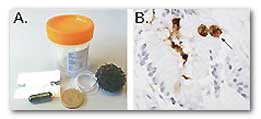|
Oesophageal cancers have become much more common
over the last 50 years and most are diagnosed at
advanced stage, when the prognosis is dismal.
Overall around 85% of patients die within 5 years of
their diagnosis. Early diagnosis would make a huge
difference to the numbers of people dying of the
disease.
Barrett’s oesophagus is a condition in which the
normal lining of the oesophagus (the squamous
epithelium) is replaced by cells that resemble the
intestine (columnar epithelium).

A: the Cytosponge® apparatus, with a Ł1 coin for
scale. B: Barrett’s cells labelled with anti-TFF3
antibodies
Barrett’s oesophagus is generally without symptoms
but is more likely to occur in people suffering from
acid reflux and it is sometimes diagnosed while
investigating heartburn. The majority of Barrett’s
oesophagus still goes undiagnosed.
This would not be a problem except individuals with
Barrett’s oesophagus are at increased risk of
oesophageal adenocarcinoma (the most common kind of
oesophageal cancer, which forms from glands that
produce mucus) and many people think that virtually
all oesophageal adenocarcinoma is preceded by
Barrett’s oesophagus.
By identifying individuals with Barrett’s oesophagus
and offering them surveillance (scheduled screening
tests) it should be possible to diagnose the cancer
early, when it is still curable. Better still, by
identifying and treating patients with pre-cancerous
changes (dysplasia) we could actually prevent
oesophageal adenocarcinoma.
This is the idea behind the BEST-2 study run by the
Cancer Prevention Trials Unit in collaboration with
Professor Rebecca Fitzgerald and colleagues from
Cambridge. Professor Fitzgerald’s team have
developed a device called Cytosponge®, which,
together with a biomarker (TFF3), can be used to
diagnose Barrett’s oesophagus without the need to
offer endoscopy to hundreds of patients.
Professor Peter Sasieni said: “This study has
demonstrated that the Cytosponge® can be easily and
safely administered to patients in an outpatient
clinic by a trained nurse. It has good sensitivity
and specificity and could be used to more easily
identify patients with Barrett’s oesophagus.
The Cytosponge® is a small sponge with a thread
attached, compressed inside a gelatine capsule.
Under the supervision of a nurse, the patient
swallows the Cytosponge®, which is the same size as
an antiobiotic capsule, while holding on to the
thread.
Once in the stomach the gelatin casing dissolves and
the sponge expands.
After a few minutes the nurse pulls the thread and
removes the sponge. As the sponge passes through the
oesophagus it collects cells and these can then be
examined under a microscope.
The BEST-2 study spanned 11 centres in the UK, with
patients who were booked for endoscopy. 647 patients
with Barrett’s oesophagus and 463 with acid reflux
(but without Barrett’s oesophagus) were recruited.
The Cytosponge® was well tolerated although about 6%
of patients (more often those with Barrett’s
oesophagus) were unable to swallow the capsule.
Overall 80% of Cytosponge® specimens from patients
with Barrett’s oesophagus stained positive for TFF3,
compared with 7.6% of those without Barrett’s
oesophagus, so the test was excellent at
differentiating between Barrett’s oesophagus and
normal tissue.
The sensitivity* was over 80% in those patients with
more extensive Barrett’s oesophagus. This is
important as the risk of cancer is greater when
Barrett’s oesophagus is more extensive. The
sensitivity and specificity** were largely
independent of age, sex, and body mass index (BMI).
This trial shows that this new screening technique
could help us detect oesophageal cancer, and
pre-cancerous changes, earlier – and save lives.
*Sensitivity: The proportion of patients with
disease who will be correctly identified by a test
**Specificity: The proportion of patients without
disease who will be correctly identified by a test
For more information
Barts Cancer Institute
New test could prevent oesophageal cancer
Cancer Research UK
The stem cell organisation, and the proliferative
and gene expression profile of Barrett's epithelium,
replicates pyloric-type gastric glands
Danielle L Lavery, Anna M Nicholson, Richard Poulsom,
Rosemary Jeffery, Alia Hussain, Laura J Gay, Janusz
A Jankowski, Sebastian S Zeki, Hugh Barr, Rebecca
Harrison, James Going, Sritharan Kadirkamanathan,
Peter Davis, Timothy Underwood, Marco R Novelli,
Manuel Rodriguez-Justo, Neil Shepherd, Marnix
Jansen, Nicholas A Wright, Stuart A C McDonald. Gut
(2014) 63.
PMID: 24550372.
Pubmed
Barrett's oesophagus
MDN |